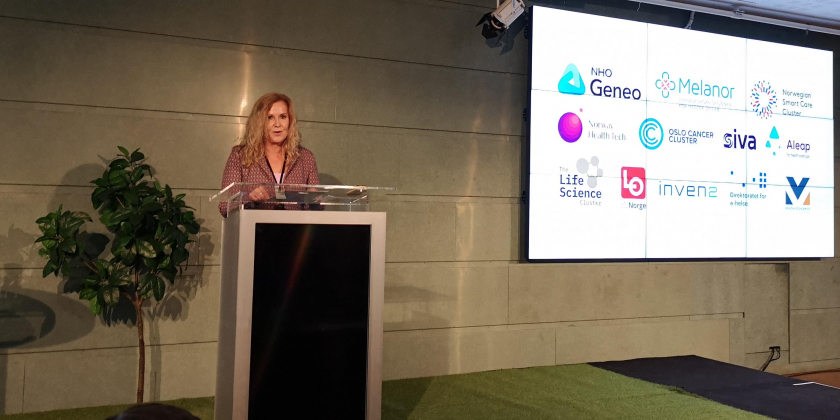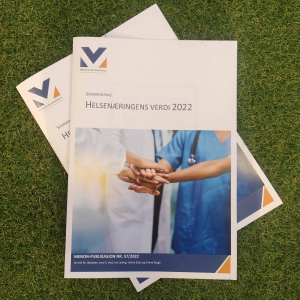“The Value of the Health Industry 2022” is here
There is a Norwegian version of this text further down.
The health industry is – and has always been – a part of the solution to many of the challenges in the healthcare sector. The industry contributes to preventing, diagnosing, and treating disease, as well as rehabilitating people. This increases the population’s quality of life, while reducing the burden on the health service, lowering sick leave, and increasing work life participation.
The Menon Economics report “The Value of the Health Industry 2022” was released on Friday 10 June 2022. The report is an annual publication, which was first published in 2016, when several key actors decided to join forces and create a report that describes the entire Norwegian health industry in numbers.
This year’s report is the seventh in line and based on three central contributions from the health industry to Norwegian economy:
- the value creation by the health industry, which contributes to increased BNP and to create jobs,
- the importance of the health industry to maintain an efficient public healthcare service,
- the importance of the health industry for public health, which reduces the burden of sickness, increases employment, and reduces health costs.
“New technologies and innovative treatments are transforming the cancer field and can create significant value for Norway as we transition to a sustainable economy. We need stronger collaboration between the public and private sector to realise the full potential of the health industry. This can reduce the burden on the healthcare service and make it both better and more efficient. This can also create new jobs and attract international investments to Norway. Above all, this can give cancer patients better health, longer lives and higher work life participation.“
Ketil Widerberg, general manager, Oslo Cancer Cluster
- Read the entire report here (in Norwegian)
These are the most important findings in the report:
1. The value creation by the health industry
- The value creation by the private health industry increased in the ten-year period from 2010 to 2020 with over 85 per cent. The corresponding growth for the rest of Norwegian private industry was nearly 25 per cent (strongly affected by the corona pandemic in 2020). The health industry constitutes an ever growing part of Norwegian industry.
- The companies in parts of the industry – especially in digital health, the pharmaceutical companies and the distribution companies in health technologies – report a very strong growth through the corona pandemic in 2020 and 2021.
- Parts of the private service industries experienced significant drops in activity – especially companies in mental health, addiction, and home and care.
- The value creation of the private health industry totalled NOK 63 billions in 2020.
- This is a little higher than the total value creation of the agricultural, forest, fishing, and aquaculture industries, which was NOK 62 billions (source: SSB, Nasjonalregnskapet).
- The exports of the health industry totalled NOK 27,2 billion in 2021.
- This is almost 60 per cent higher than the export of power in 2021.
- The private health industry employed 83 500 people in the Norwegian economy in 2021.
- This constitutes a little more than three per cent of all employment in the Norwegian economy.
- This corresponds 35 per cent of the employment in the building and construction industry.
2. The importance of the health industry for the public healthcare service
- The majority of the income (from Norway) to the private health industry comes from customers in the public sector – municipalities, public hospitals and other national public institutions.
- Health technology, which is developed and delivered by the health industry, is essential to ensure that the public healthcare sector delivers high-quality health and care services in an efficient manner.
- At the same time, the health industry is dependent on that the buyers in the public healthcare sector use the market in an efficient manner, in other words, that they are open to procuring new products and services. This is essential for private companies to gain access to growth capital and to be able to establish themselves abroad.
- The mapping of the health industry’s experiences of interacting with the public healthcare sector shows several interesting findings;
- The health industry perceives that the competency of the buyers in the municipalities is very low, while it is perceived as very high in the public hospitals.
- The customers in the municipalities put a very high emphasis on price (at the expense of quality) in the procurement of health technology. The suppliers of private healthcare services are presented as the type of customer that emphasize quality the highest, when procuring health technology.
- The suppliers of private healthcare services are perceived to be the type of customer who are most open to procuring new technology, and innovative products and services. Also in this area, the customers in the municipalities are perceived to be “the worst” among suppliers of health technology.
3. The importance of the health industry for public health
- The societal costs of disease and health in Norway constitute two thirds of the BNP. These costs include:
- The burden of disease – the economic value of lost years of life and the damage to health in the population because of disease and injury.
- The cost of health services – the cost of equipment and services in the health sector.
- Loss in production – the value creation that is not realised because of the people not able to work because of disease or injury.
- Innovations in the health industry continuously contribute to reducing these costs. In this report, we present several examples of technology developed by the Norwegian health industry that increase the quality of treatment and increase the efficiency of diagnostics, treatment and follow-up of patients and users.
- Paradoxically, the benefits from saved lives and better health are valued less today in the healthcare sector, than in other societal sectors, in the calculations of utility and cost efficiency in public budgets.
- This can lead to a systematic underestimation of the value of investments in the healthcare sector compared to investments in life and health in other sectors.
Read previous reports here (in Norwegian)
- Helsenæringens verdi 2021
- Helsenæringens verdi 2020
- Helsenæringens verdi 2019
- Helsenæringens verdi 2018
- Helsenæringens verdi 2017
- Verdiskaping i helsenæringen 2016
The consortium partners: Aleap, The Norwegian Directorate for e-health, Inven2, LO Norway, Melanor, Norway Health Tech, Norwegian Smart Care Cluster, Oslo Cancer Cluster, SIVA, The Life Science Cluster, The Confederation of Norwegian Enterprize (NHO) and NHO Geneo.
Read the press release in Norwegian below:
Dette er de viktigste funnene i «Helsenæringens verdi 2022»
Helsenæringen er – og har alltid vært – en del av løsningen på mange av våre helse- og omsorgsutfordringer. Næringen bidrar til å forebygge, diagnostisere, behandle og rehabilitere mennesker, noe som øker befolkningens livskvalitet, samt bidrar til å redusere belastningen på helsevesenet, redusere sykefraværet og til økt deltakelse i arbeidslivet.
Fredag 10. juni offentliggjøres Menon Economics-rapporten «Helsenæringens verdi 2022». Rapporten er en årlig utgivelse, som for første gang ble publisert i 2016 da de toneangivende aktørene innen helsenæringen i Norge for første gang gikk sammen om å utarbeide en rapport hvor målet var å beskrive hele den norske helsenæringen i tall.
Årets rapport, som er den sjette i rekken, tar utgangspunkt i tre sentrale bidrag fra helsenæringen til norsk økonomi: Helsenæringens verdiskaping – bidrag til BNP og arbeidsplasser, helsenæringens betydning for en effektiv offentlig helsetjeneste og helsenæringens betydning for folkehelsen – redusert sykdomsbyrde, økt sysselsetting og reduserte helsetjenestekostnader.
Her er hovedfunnene:
1. Helsenæringens verdiskaping
- Verdiskapingen i den private helsenæringen steg i tiårsperioden fra 2010 til 2020 med over 85 prosent. Den tilsvarende verdiskapings-veksten for resten av norsk privat næringsliv var på i underkant av 25 prosent (sterkt preget av korona-pandemien i 2020). Helsenæringen utgjør en stadig større andel av norsk næringsliv.
- Bedriftene i deler av næringen – især digital helse, legemiddelbedriftene og distribusjons-bedrifter innen helseteknologi – rapporterer om en svært sterk vekst gjennom korona-pandemien i 2020 og 2021.
- Deler av de private tjenestebransjene opplevde betydelig aktivitetsfall – især aktører innen psykisk helse og avhengighet og bo og omsorg.
- Den private helsenæringen hadde en samlet verdiskaping i 2020 på 63 mrd. NOK
- Dette er litt høyere enn den samlede verdiskapingen i de to primærnæringene jord- og skogbruk og fiske, fangst og akvakultur, med samlet 62 mrd. NOK i verdiskaping (kilde: SSB, Nasjonalregnskapet)
- Helsenæringen hadde i 2021 en samlet eksport på 27,2 mrd. NOK
- Dette er nesten 60 prosent høyere enn verdien av krafteksporten i 2021
- Den private helsenæringen sysselsatte i 2021 83.500 personer i norsk økonomi
- Tilsvarer i overkant av tre prosent av all sysselsetting i norsk økonomi
- Tilsvarer 35 prosent av sysselsettingen i bygg- og anleggsnæringen
2. Helsenæringens betydning for den offentlige helsetjenesten
- Majoriteten av inntektene (fra Norge) til den private helsenæringen kommer kunder i offentlig sektor – kommuner, offentlige helseforetak og andre nasjonale offentlige institusjoner.
- Helseteknologi utviklet og levert av helseindustrien er avgjørende for at den offentlige helsesektoren får levert helse- og omsorgstjenester av høy kvalitet, på en effektiv måte
- Samtidig er helsenæringen avhengig av at innkjøperne i den offentlige helsesektoren benytter markedet på en effektiv måte, herunder at de er åpne for å anskaffe nye produkter og tjenester, for både å få tilgang til vekstkapital og for å kunne etablere seg i utlandet
- Kartlegging av helsenæringens opplevelser av samhandlingen med den offentlige helsesektoren gir flere interessante funn;
- Helsenæringen oppfatter innkjøpskompetansen gjennomgående er svært lav i kommune-sektoren, mens den oppfattes som svært høy i helseforetakene.
- Kundene i kommunesektoren vektlegger pris svært høyt (på bekostning av kvalitet) i anskaffelser av helseteknologi. Private helsetjenesteleverandører trekkes frem som den kundetypen som vektlegger kvalitet høyest, ved anskaffelser av helseteknologi.
- De private helsetjenesteleverandørene oppfattes å være kundetypen som er mest åpne for å anskaffe ny teknologi og innovative produkter og tjenester. Også på dette området oppleves kunder i kommunesektoren å være «dårligst» blant leverandørene av helseteknologi.
3. Helsenæringens betydning for folkehelsen
- Samfunnskostnadene av sykdom og helse i Norge tilsvarer to tredeler av brutto nasjonalprodukt (BNP). Disse kostnadene består av;
- Sykdomsbyrden – den økonomiske verdien av tapte leveår og helsetap i befolkningen som følge av sykdom og skader.
- Helsetjenestekostnader – kostnadene av utstyr og tjenester i helsesektoren
- Produksjonstapet – verdiskapingen som ikke realiseres som følge av at arbeids-kraftressurser er ute av stand til å jobbe, som en konsekvens av sykdom og skader
- Innovasjoner i helsenæringen bidrar kontinuerlig til å redusere disse kostnadene. I denne rapporten presenterer vi en rekke eksempler på teknologi utviklet av den norske helsenæringen som øker behandlingskvaliteten og øker effektiviteten i diagnostisering, behandling og oppfølging av pasienter og brukere.
- Paradoksalt nok er det i dag slik at gevinsten av sparte liv og bedre helse verdsettes lavere i helsesektoren, enn i andre samfunnssektorer, i beregninger av nytte- og kostnadseffekter av offentlige budsjettkroner.
- Dette kan føre til en systematisk undervurdering av verdien av investeringer i helsesektoren sammenlignet med investeringer i liv og helse i andre sektorer.
Les hele rapporten her.
Deltakerne i konsortiet er: Aleap, Direktoratet for e-helse, Inven2, Landsorganisasjonen i Norge (LO), Melanor, Norway Health Tech, Norwegian Smart Care Cluster, Oslo Cancer Cluster, SIVA, The Life Science Cluster, Næringslivets Hovedorganisasjon (NHO) og NHO Geneo.













